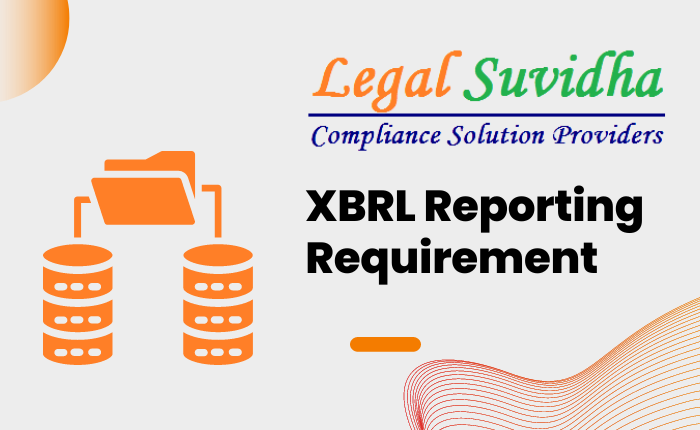XBRL (eXtensible Business Reporting Language) reporting is a requirement for filing financial statements with the Ministry of Corporate Affairs (MCA) in certain countries, including India. XBRL is a standardized language used for the electronic communication of business and financial data.
The MCA has implemented the XBRL reporting requirement to enhance the transparency, accuracy, and accessibility of financial information submitted by companies. Here is an overview of the XBRL reporting requirement for MCA filings:
1. Applicability: XBRL reporting is applicable to specific categories of companies based on their size, turnover, and other criteria. Generally, it applies to large companies, listed companies, and certain other entities as prescribed by the MCA.
2. Financial Statements: The financial statements required to be filed in XBRL format include the balance sheet, profit and loss account, cash flow statement, statement of changes in equity, and any other statements or schedules that form part of the financial statements.
3. XBRL Taxonomy: The MCA provides a standard taxonomy, which is a structured dictionary of tags that represent various financial concepts and elements. This taxonomy is used to tag the financial data in the XBRL format.
4. Tagging Financial Data: Companies are required to map the financial data in their financial statements to the corresponding tags in the XBRL taxonomy. Each line item in the financial statements, such as assets, liabilities, revenues, expenses, etc., needs to be tagged appropriately.
5. XBRL Software: To prepare the financial statements in XBRL format, companies need to use XBRL-enabled software. This software facilitates the mapping of financial data to XBRL tags and generates the XBRL instance document.
6. XBRL Instance Document: The XBRL instance document is the final output generated by the XBRL software. It contains the tagged financial data in XBRL format and serves as the electronic filing for MCA submissions.
7. Filing Process: Once the XBRL instance document is generated, it needs to be uploaded to the MCA portal or any other designated platform as specified by the MCA. The document is then validated for compliance with XBRL rules and regulations before the filing is considered complete.
8. Penalties for Non-Compliance: Non-compliance with the XBRL reporting requirement may attract penalties or consequences as per the laws and regulations of the respective country. It is important for companies to adhere to the XBRL filing deadlines and ensure the accuracy of the tagged financial data.
Applicability of XBRL Filing for Companies
The applicability of XBRL filing for companies can vary depending on the regulations of the specific jurisdiction. Here are some general factors that determine the applicability of XBRL filing:
1. Company Size: XBRL filing requirements often apply to companies of a certain size. Large companies, listed companies, and public companies are more likely to be subject to XBRL filing obligations. Small or medium-sized enterprises (SMEs) may be exempt from XBRL reporting requirements, but this can vary depending on the jurisdiction.
2. Regulatory Requirements: Regulatory bodies or government agencies may mandate XBRL filing for certain types of companies or industries. These requirements aim to improve the accessibility, comparability, and transparency of financial information. For example, in some countries, financial institutions, insurance companies, or entities regulated by securities commissions may be required to file financial statements in XBRL format.
3. Stock Exchange Listing: Companies listed on stock exchanges may be required to submit their financial statements in XBRL format as part of their regulatory obligations. This ensures consistency in reporting and facilitates analysis and comparison of financial data by investors, analysts, and regulatory authorities.
4. Government Filings: In some jurisdictions, government agencies responsible for company registration and oversight may require XBRL filing for certain types of reports or filings. This can include annual financial statements, tax filings, or other regulatory submissions.
5. Country-Specific Regulations: XBRL filing requirements can vary from country to country. Each jurisdiction may have its own set of rules, regulations, and timelines for XBRL filing. Companies operating in multiple countries need to comply with the XBRL requirements of each jurisdiction they operate in.
The documents required for XBRL filing can vary depending on the jurisdiction and the specific reporting requirements. However, here are some common documents that are typically needed for XBRL filing:
1. Financial Statements: The primary documents required for XBRL filing are the financial statements, which include the balance sheet, profit, and loss account (income statement), cash flow statement, and statement of changes in equity. These statements should be prepared in accordance with the relevant accounting standards or regulations.
2. Notes to the Financial Statements: In addition to the financial statements, companies may need to provide accompanying notes that provide further explanations, disclosures, and details related to the financial data. These notes are an integral part of the financial statements and may also require tagging in XBRL format.
3. Supporting Schedules and Statements: Depending on the reporting requirements, companies may need to include supporting schedules or statements that provide more detailed breakdowns of specific financial elements. For example, schedules for fixed assets, inventory, debt, or revenue recognition may be required.
4. Management Discussion and Analysis (MD&A): Some jurisdictions may require the inclusion of a management discussion and analysis section. This section provides a narrative explanation of the company’s financial performance, key risks, strategies, and other relevant information. In XBRL filing, this section may need to be tagged accordingly.
5. Corporate Governance Reports: Certain jurisdictions may require companies to provide corporate governance reports or statements, which detail the company’s governance practices, board composition, audit procedures, and other related information. These reports may also need to be included in the XBRL filing.
6. XBRL Instance Document: The XBRL instance document itself is a crucial part of the filing. It is the final output generated by the XBRL software and contains the tagged financial data. This document is uploaded or submitted electronically to the designated platform or regulatory authority.
It’s important to note that the specific documents required for XBRL filing can vary depending on the jurisdiction, regulatory requirements, and type of company. Companies should refer to the guidelines and instructions provided by the relevant regulatory authority or a government agency to determine the specific documents needed for XBRL filing in their jurisdiction.
XBRL Taxonomy and Instance Document
The XBRL taxonomy is a structured dictionary or set of standardized tags that represent various financial concepts and elements. It provides a framework for organizing and categorizing financial data in a consistent manner. The taxonomy defines the specific tags or labels used to describe each element in the financial statements, such as assets, liabilities, revenues, expenses, etc.
The XBRL taxonomy is designed to be comprehensive and cover a wide range of financial reporting elements. It includes predefined tags for commonly used financial concepts, as well as the flexibility to create custom tags for unique elements specific to a company or industry. The taxonomy is typically developed and maintained by regulatory authorities, standard-setting bodies, or industry organizations.
The taxonomy ensures that financial data can be accurately and consistently represented in XBRL format. It facilitates the mapping or tagging of the financial data from the company’s financial statements to the corresponding elements in the XBRL taxonomy.
XBRL Instance Document:
The XBRL instance document is the final output generated by the XBRL-enabled software after mapping the financial data to the tags in the XBRL taxonomy. It is an XML (eXtensible Markup Language) file that contains the tagged financial data in XBRL format.
The XBRL instance document represents the electronic filing or submission of financial statements in XBRL format. It includes the complete set of tagged financial data, including the balance sheet, income statement, cash flow statement, and any other schedules or notes that are required for reporting.
The XBRL instance document is structured in a hierarchical manner, reflecting the relationships between different financial elements. It captures the numeric values, units of measurement, and other relevant information associated with each tagged element. The instance document also includes metadata, such as the reporting period, currency, and context information that provides additional context to the financial data.
Once the XBRL instance document is generated, it can be uploaded or submitted electronically to the designated platform or regulatory authority as specified by the filing requirements. The instance document is used for validation, analysis, and processing of the financial data in XBRL format by regulators, investors, analysts, and other stakeholders.
Overall, the XBRL taxonomy and instance document work together to enable the standardized representation and exchange of financial information in a machine-readable format, improving transparency, comparability, and efficiency in financial reporting and analysis.
Benefits of XBRL Filing
XBRL (eXtensible Business Reporting Language) filing offers several benefits for businesses and regulatory authorities. Here are some key advantages of XBRL filing:
1. Enhanced Efficiency: XBRL enables businesses to automate the process of preparing and submitting financial reports. It standardizes the format and structure of financial data, making it easier to collect, validate, analyze, and exchange information. This automation saves time, reduces errors, and enhances overall efficiency in financial reporting.
2. Improved Accuracy and Reliability: XBRL eliminates manual data entry and minimizes the risk of human errors associated with traditional reporting methods. By using predefined tags and data validation rules, XBRL ensures that financial information is accurately represented and consistent across different reports and platforms. This improves the reliability and credibility of financial statements.
3. Simplified Data Analysis: XBRL allows for easy extraction and analysis of financial data. The standardized tags and structures enable automated data processing, which facilitates comparisons, benchmarking, and trend analysis. Investors, analysts, and regulators can quickly access and analyze financial information across different companies, industries, or periods, enabling better decision-making.
4. Enhanced Transparency and Accessibility: XBRL enhances the transparency of financial reporting by providing a standardized and machine-readable format. Investors, regulators, and other stakeholders can access and analyze financial data in a more transparent and consistent manner. This promotes greater accountability and facilitates the dissemination of financial information to a wider audience.
5. Cost Savings: Adopting XBRL reduces the costs associated with manual data entry, paper-based reports, and manual review processes. XBRL streamlines reporting workflows eliminates the need for multiple versions of financial statements, and reduces the time and effort required for data validation and analysis. These cost savings can be significant for both businesses and regulatory authorities.
6. Compliance with Regulatory Requirements: Many regulatory authorities around the world have adopted XBRL as the standard for financial reporting. By using XBRL, businesses can ensure compliance with these reporting requirements, avoiding penalties or delays in submitting financial statements. XBRL also facilitates regulatory oversight and improves the efficiency of data collection and analysis for regulatory purposes.
Overall, XBRL filing offers numerous benefits, including increased efficiency, accuracy, transparency, and cost savings. It streamlines financial reporting processes, improves data analysis capabilities, and promotes standardized and consistent reporting practices across organizations and industries.
If You have any queries then connect with us at [email protected] or [email protected] & contact us & stay updated with our latest blogs & articles





















